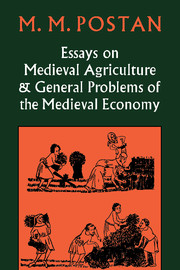Book contents
- Frontmatter
- Preface
- Acknowledgements
- Contents
- I GENERAL
- II AGRARIAN
- 7 The chronology of labour services
- 8 The charters of the villeins
- 9 Heriots and prices on Winchester manors with statistical notes on Winchester heriots by J. Longde (Graphs appear between pp. 174 and 175)
- 10 Some agrarian evidence of a declining population in the later Middle Ages
- 11 Village livestock in the thirteenth century
- 12 Glastonbury estates in the twelfth century
- 13 Legal status and economic condition in medieval villages
- Index
- Plate section
7 - The chronology of labour services
Published online by Cambridge University Press: 05 November 2011
- Frontmatter
- Preface
- Acknowledgements
- Contents
- I GENERAL
- II AGRARIAN
- 7 The chronology of labour services
- 8 The charters of the villeins
- 9 Heriots and prices on Winchester manors with statistical notes on Winchester heriots by J. Longde (Graphs appear between pp. 174 and 175)
- 10 Some agrarian evidence of a declining population in the later Middle Ages
- 11 Village livestock in the thirteenth century
- 12 Glastonbury estates in the twelfth century
- 13 Legal status and economic condition in medieval villages
- Index
- Plate section
Summary
The chronology of labour services in the Middle Ages has been agitating agrarian historians for nearly a hundred years. In view of this, it is surprising to find how many of the dates are still a matter of assumption. On the whole, economic historians know much more about the final demise of labour dues than about their previous history. They may disagree as to the exact dates of the fourteenth-century commutation, or as to the extent to which England had been manorialized and was therefore likely to be affected by the dissolution of the manor. But, on the whole, they are agreed that commutation did take place in those parts of the country which were manorialized; and it would be generally accepted that commutation was rare in the first quarter of the fourteenth century, that labour services were exceptional in the last quarter of the fifteenth century, and that consequently the final substitution of money for labour dues took place some time between the first quarter of the fourteenth century and the last quarter of the fifteenth.
This may not be much to show for half a century of research, but little as it is, it is a great deal more than is known about labour services in the preceding periods. Were they rising, stationary, or falling, and if they fell or rose how are the ups and downs to be dated? None of these questions has been answered, and for England as a whole they have not even been asked.
- Type
- Chapter
- Information
- Publisher: Cambridge University PressPrint publication year: 1973
- 2
- Cited by

